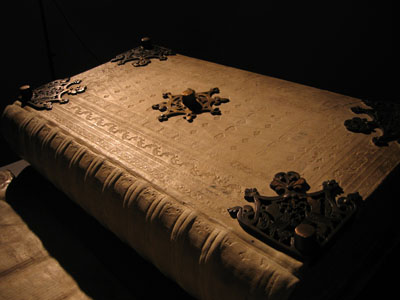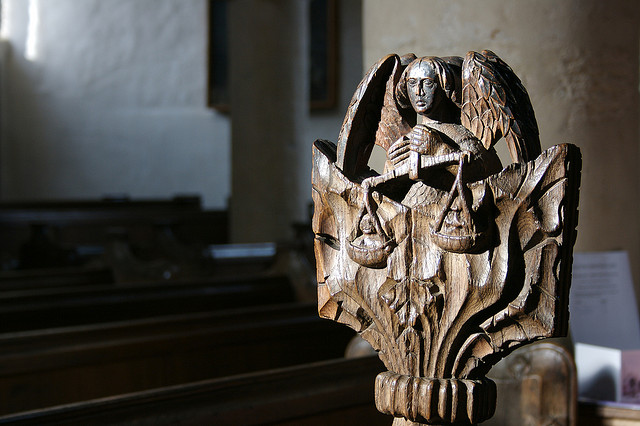 |
| Codex Gigas; 1200-1230 |
A long time ago in a Bohemian monastery a Benedictine monk was sentenced to be walled-up. Yet he managed to bargain for his life and made a deal that he will write a book containing all knowledge in one night and if he fails he will submit to his punishment. He set out to work yet by the middle of the night he realised that he is not going to make it. Desperate he summoned the devil, who agreed to help the monk at the cost of his soul and a promise that he would include his 'portrait' in to the work. This is the legend of the Codex Gigas or The Devil's Bible.
Codex Gigas or in translation The Giant Book is exactly that - a giant 13th century book. The manuscript is 89cm x 49cm (in other words almost a meter by half meter), which makes it the size of an average 4 year old child. It weights 75 kg - same as an average adult male and is made out of 310 leaves of parchment this means that around 150 calfs were needed to produce it. Considering these sizes it is no surprise that this is the biggest manuscript in the world
If there is a book that is borderline bonkers in its ambition it is Codex Gigas. The ambition of the scribe it seems was to bind underneath one cover all the existing knowledge of the world or in anachronistic terms to create a proto - encyclopaedia. The book consists not only of the Bible but also history books, treatesis on medicine and magic, it also has alphabets of various languages. In essence it does posses much of the knowledge available in the 13th century. Yet it is famous not so much for holding a library underneath its cover but for a depiction of the Devil (which plausibly lends its name to the manuscript).
The Codex Devil takes up the whole page. It is a squatting (ready to pounce?) humanoid figure with hybrid traits such as red horns and tallons, reptilian halo, green face, and two snakes coming out of its mouth. The halo like figure is probably a stylised halo, as the halo used to be a symbol of power rather than divinity. An interesting physical trait of the parchment on which the devil is depicted and the near lying pages is that it has black shadows and dislocations The superstitious saw this as 'the satanic influence' and reinforced the demonic connection. As it turned out the dark shades are pigmentation patches caused by sunlight Other pages didn't have them because they were not viewed as often as the Devil page. In an ironic way this tells a lot about people in general when holding a book with all knowledge we ignore the text and go for the 'cool' picture.
 |
| Codex Gigas, f 289v/290r |
I should notice that the devil is not fully alone, opposite him is the Kingdom of Heaven (something that some sources tend to ignore) thus the two together can be seen as the two choices of man, in other words they are a grander depiction of the same idea that is seen in images of Michael holding the scales and weighting the souls.
 |
| Ickleton Church, Cambridgeshire. Poppy-head pew end. 15th or 16th cent |
What absolutely bewilders me in this devil is that he is alone on his page, out of context and he is framed. All of this is unique, and important. The devil at least when counterbalanced with Heaven was usually shown with his unholy court for example like in Livre de la Vigne or he was shown in Hell. In either way there was a context, a narrative that would help the viewer to understand that this is the devil and not an imp, or a random monster. Here its a blank page - this assumes that the audience will intrinstically understand that this is the devil and not just a random monstrosity. Or arguably it is the the juxtaoosition with the Kingdom of Heaven that gives the devil its context. Then it is Heaven that turns this 'random monster' in to the ultimate Evil.
The fact that he is framed is also important. Frames are now undervalued, but they do offer help and meaning in interpretation. Framing devices were often used symbolically for example the enclosed garden in which Virgin Mary is presented in so many Western paintings represents her virginity. In this case the Devil though present on the page, is framed off from everything, he is framed off from us. This frame is a protection and a boundary, a border post. This frame reminds me a lot of the framed Blemmye from the Marvels of the East. With the difference that the Blemmye is physically holding the frame and is standing on it - about to take a step and transgress the boundary between his world and ours (like the girl climbing out of the TV in Ring).
 |
| Blemmye, The Wonders of the East, c.1050.jpeg |
Interestingly there is no space between the Devil and the frame he takes up all the space within it, this in my view is done to communicate his gigantic size, it also could be an attempt to depict him in a prison cell, after all he wasn't meant to be the ruler of hell but an inmate. I also find the emptiness very unsettling usually hell is when medieval imagination ran crazy and here we have a very Plutonian representation - evil as nothing, as non being.
Also there is an opening at the top and I wonder if the shape of the frame could in any way be a reference to the pit? Or is it a hint that there is a way to get in, we are not completely closed off from the Devil and Hell, though he can not climb out to get us we can 'fall' in. Or is it just mirroring the frame surrounding the Heavenly Kingdom? Yet if the Devil is framed off from us, here it is us who are famed off from the Kingdom. The frame offers something like a window in to the world we long for. Thus the frame has a double role depending on the context - to keep the Devil out and not to let us in.
This Codex is not only wondrous in it self but it has an absolutely epic history of travel from the Bohemian countryside to two very unique Royal courts. It is believed that the Codex was written in Podlažice monastery in Bohemia (Czech Republic), because of financial dificulties it was sold to the Cistercians at Sedlec monastery. Sedlec was famous for having earth from Golgotha sprinkled over its cemetary in the 13th century which made it very desirable burial ground. In the 14th century the cemetery was enlarged because of the Black Death. A century later a church of All -Saints was erected and a century after that the bones were dug up and moved to the lower level of the church creating an unforgetable crypt decorated by the bones of about 40,000.
 |
| Sedlec Ossuary, All Saints Chapel |
 |
| Sedlec Ossuary |
It should be mentioned that the first properly documented location of the manuscript is Bavor and we know about Podlažice and Sedlec from an inscription made in 1295. Many dispute the origins in Podlažice, because to produce such a work two factors are crucial money and sources. In other words you must be able to afford the 310 calf skins and you must have a scriptorium which has the manuscripts which make the Codex Gigas. Podlažice does not really fit the description it was a fairly small and fairly poor monastery for such a manuscript. Yet of lack of better theories and because of the inscription it is assumed to be the place of origin.
If you read this far, good as I saved the best for last. In one regard the legend did get it right - the manuscript is not a product of a scriptorium but one man! Yes 310 calfskins (and thats what we have left, originally the thing used to be a few calf skins larger) were written on in minute handwriting by one monk. Hermann Inclusus ( Herman the recluse) is the supposed name of the monk in question. It is unknown if he took this task as penitence or to glorify God. The one scribe theory thought hard to believe is supported by the analysis of the ink and handwriting which is as individual as a finger print. This makes this manuscript a lives work, and interestingly the dates for its creation 1200 - 1230 are fairly accurate because it would have take one monk around 30 years to complete such a task.
And the best part you can look at the digitised version of the manuscript here.
